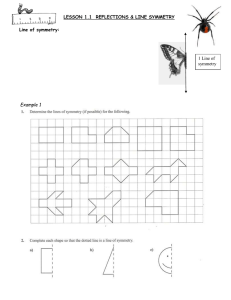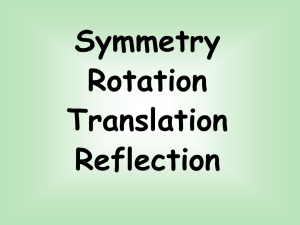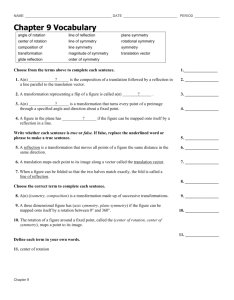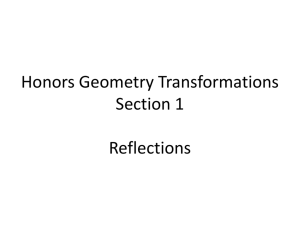The Four Planes of Symmetry
advertisement
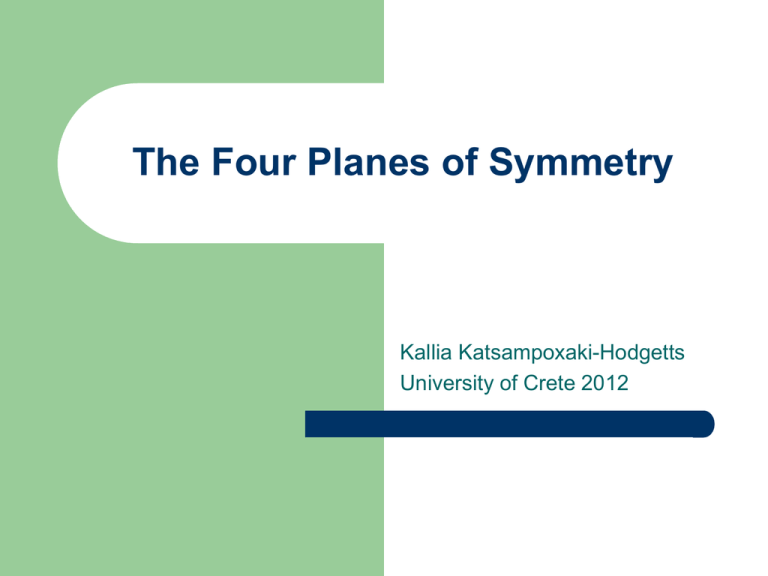
The Four Planes of Symmetry Kallia Katsampoxaki-Hodgetts University of Crete 2012 Symmetry A repeating pattern in a plane. A pattern is symmetric if there is at least one symmetry that leaves the pattern unchanged. Symmetries In mathematics, the idea of symmetry gives us a precise way to think about this subject. We will talk about plane symmetries, those that take place on a flat plane, but the ideas generalize to spatial symmetries too. Types of Symmetry Translation Rotation Glide Reflection Reflection Translation Translation Properties A translation is defined by its direction and/or distance. Two objects are symmetrical under translation if one can be superimposed on the other such that their edges match up perfectly. A translation It is a shape that is simply translated, or slid, across the paper and drawn again in another place. It shows the geometric shape in the same alignment as the original; it does not turn or flip. Rotation To rotate an object means to turn it around. Every rotation has a center and an angle. Rotational Symmetry Rotation is spinning the pattern around a point, rotating it. A rotation, or turn, occurs when an object is moved in a circular fashion around a central point (i,.e origin) which does not move. Formally, rotational symmetry is symmetry with respect to some or all rotations in m-dimensional Euclidean space. Rotations are direct isometries, i.e., isometries preserving orientation. Rotation Symmetrical object under Rotation It appears the same when rotated about its center some fraction of 360 degrees. The most common types of rotational symmetries are 90 and 180 degree rotations, but others such as 45 and 60 also occur. For example, the number "6" is symmetrical to the number "9" under 180-degree rotation. Reflectional Symmetry Reflection symmetry, line symmetry, mirror symmetry, mirror-image symmetry, or bilateral symmetry is symmetry with respect to reflection. A type of symmetry in which one half of the object is the mirror image of the other. In 2D there is a line of symmetry, in 3D a plane of symmetry. An object or figure which is indistinguishable from its transformed image is called mirror symmetric. Reflection Symmetry about a vertical line of reflection. The hexagon has reflectional symmetry about both horizontal and vertical lines of reflection. Related Terms for Reflectional Symmetry Flip Horizontal Line Vertical Line Mirror Symmetry Reflection symmetry, line symmetry, mirror symmetry, mirror-image symmetry, or bilateral symmetry is symmetry with respect to reflection. Properties of Reflections Reflections exhibit 1. Collinearity 2. Betweenness 3. Distance --length or linear measure 4. Angle measure Reflections do not preserve orientation. Reflections reverse orientation. Solve a Problem The letter B has reflectional symmetry. Identify the list of other alphabets with similar reflection. Choices: 1. A, H, I, M, O, T, U, W, X, Y 2. C, D, E, H, I, O, X 3. F, G, J, L, Q, R, S, Z 4. A, B, C, D, E, H, I, K, M, O, T, U, X, Y Steps before the Solution Step 1: A reflection flips the figure across a line. The new figure is a mirror image of the original figure. Step 2: The alphabet 'B' has horizontal reflection because half a figure is a mirror image of the other half. Solution The other alphabets with similar reflection are C, D, E, H, I, O, X. Glide Reflection Glide Reflection Glide reflection is the only type of symmetry that is a combination of two symmetries. It combines a reflection with a translation along the direction of the mirror line. It is also the only type of symmetry that involves more than one step. Glide Reflections In glide reflection, Reflection and translation are used concurrently much like the following piece by Escher, Horseman. There is no reflectional symmetry, nor is there rotational symmetry. Tesselations If you look at a completed tessellation, you will see the original motif repeats in a pattern. One mathematical idea that can be emphasized through tessellations is symmetry. There are 17 possible ways that a pattern can be used to tile a flat surface or 'wallpaper'. Find the symmetry References http://math.hws.edu/eck/math110_s08/symm etries/index.html http://mathforum.org/sum95/suzanne/symsus an.html http://www.csun.edu/~lmp99402/Math_Art/Te sselations/tesselations.html http://www.ehow.com/info_8465413_different -kinds-symmetries-math.html Task 1: True or False? Plane symmetry means a symmetry of a pattern in the Euclidean plane; that is, a transformation of the plane that carries any directioned lines to lines and preserves many different distances. A pattern is symmetric if there is at least one symmetry that leaves the pattern changed. In 2D and 3D there is a plane of symmetry. An object or figure which is indistinguishable from its transformed image is called mirror. Task 2:Complete the gaps 1. An object that is symmetrical under reflection is the ………..of the other object. Objects with reflectional symmetry are categorized by the ……….of the axis of symmetry: vertical, horizontal or slant. For example, the letter "W" has reflectional symmetry with the letter "M" along a ………axis. 2. Rotation is …….the pattern around a point, rotating it. A rotation, or turn, occurs when an object is moved in a …………..around a central point which does not move. 3. Symmetry under translation refers to simply moving the object horizontally, vertically or both ………rotating or reflecting it. A translation is defined by its direction and/or….. Two objects are symmetrical under translation if one can be ……….on the other such that their edges match up perfectly. It shows the geometric shape in the same a…….. as the original; it does not flip. 4. ……reflection is the only type of symmetry that is a …...............of two symmetries. Two objects are symmetrical under glide reflection if one is a reflection of the other and is translated …………….the axis of symmetry. Task 3: Dictogloss Step 1: Listen to the instructor reading a short text on the four planes of symmetry and take notes. Step 2: Reconstruct the text after comparing notes with a partner.
